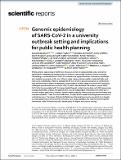Files in this item
Genomic epidemiology of SARS-CoV-2 in a university outbreak setting and implications for public health planning
Item metadata
| dc.contributor.author | Nickbakhsh, Sema | |
| dc.contributor.author | Hughes, Joseph | |
| dc.contributor.author | Christofidis, Nicolaos | |
| dc.contributor.author | Griffiths, Emily | |
| dc.contributor.author | Shaaban, Sharif | |
| dc.contributor.author | Enright, Jessica | |
| dc.contributor.author | Smollett, Katherine | |
| dc.contributor.author | Nomikou, Kyriaki | |
| dc.contributor.author | Palmalux, Natasha | |
| dc.contributor.author | Tong, Lily | |
| dc.contributor.author | Carmichael, Stephen | |
| dc.contributor.author | Sreenu, Vattipally B. | |
| dc.contributor.author | Orton, Richard | |
| dc.contributor.author | Goldstein, Emily J. | |
| dc.contributor.author | Tomb, Rachael M. | |
| dc.contributor.author | The COVID-19 Genomics UK (COG-UK) Consortium | |
| dc.contributor.author | Templeton, Kate | |
| dc.contributor.author | Gunson, Rory N. | |
| dc.contributor.author | da Silva Filipe, Ana | |
| dc.contributor.author | Milosevic, Catriona | |
| dc.contributor.author | Thomson, Emma | |
| dc.contributor.author | Robertson, David L. | |
| dc.contributor.author | Holden, Matthew | |
| dc.contributor.author | Illingworth, Christopher J. R. | |
| dc.contributor.author | Smith-Palmer, Alison | |
| dc.date.accessioned | 2022-07-28T10:30:27Z | |
| dc.date.available | 2022-07-28T10:30:27Z | |
| dc.date.issued | 2022-07-19 | |
| dc.identifier | 280643937 | |
| dc.identifier | d86f1638-319a-481a-80a7-d8bf5f43e83c | |
| dc.identifier | 85134374428 | |
| dc.identifier | 000827810800080 | |
| dc.identifier.citation | Nickbakhsh , S , Hughes , J , Christofidis , N , Griffiths , E , Shaaban , S , Enright , J , Smollett , K , Nomikou , K , Palmalux , N , Tong , L , Carmichael , S , Sreenu , V B , Orton , R , Goldstein , E J , Tomb , R M , The COVID-19 Genomics UK (COG-UK) Consortium , Templeton , K , Gunson , R N , da Silva Filipe , A , Milosevic , C , Thomson , E , Robertson , D L , Holden , M , Illingworth , C J R & Smith-Palmer , A 2022 , ' Genomic epidemiology of SARS-CoV-2 in a university outbreak setting and implications for public health planning ' , Scientific Reports , vol. 12 , 11735 . https://doi.org/10.1038/s41598-022-15661-1 | en |
| dc.identifier.issn | 2045-2322 | |
| dc.identifier.other | ORCID: /0000-0002-0370-3700/work/116598120 | |
| dc.identifier.other | ORCID: /0000-0002-4958-2166/work/116598348 | |
| dc.identifier.other | PubMedCentral: PMC9296497 | |
| dc.identifier.uri | https://hdl.handle.net/10023/25737 | |
| dc.description | Funding: The CVR authors are supported by the Medical Research Council [MC_UU_12014/12 and MC_UU_12018/12]. COG-UK is supported by funding from the Medical Research Council (MRC) part of UK Research & Innovation (UKRI), the National Institute of Health Research (NIHR) [Grant code: MC_PC_19027], and Genome Research Limited, operating as the Wellcome Sanger Institute. | en |
| dc.description.abstract | Whole genome sequencing of SARS-CoV-2 has occurred at an unprecedented scale, and can be exploited for characterising outbreak risks at the fine-scale needed to inform control strategies. One setting at continued risk of COVID-19 outbreaks are higher education institutions, associated with student movements at the start of term, close living conditions within residential halls, and high social contact rates. Here we analysed SARS-CoV-2 whole genome sequences in combination with epidemiological data to investigate a large cluster of student cases associated with University of Glasgow accommodation in autumn 2020, Scotland. We identified 519 student cases of SARS-CoV-2 infection associated with this large cluster through contact tracing data, with 30% sequencing coverage for further analysis. We estimated at least 11 independent introductions of SARS-CoV-2 into the student population, with four comprising the majority of detected cases and consistent with separate outbreaks. These four outbreaks were curtailed within a week following implementation of control measures. The impact of student infections on the local community was short-term despite an underlying increase in community infections. Our study highlights the need for context-specific information in the formation of public health policy for higher educational settings. | |
| dc.format.extent | 17 | |
| dc.format.extent | 3701856 | |
| dc.language.iso | eng | |
| dc.relation.ispartof | Scientific Reports | en |
| dc.subject | QH426 Genetics | en |
| dc.subject | RA0421 Public health. Hygiene. Preventive Medicine | en |
| dc.subject | 3rd-DAS | en |
| dc.subject | SDG 3 - Good Health and Well-being | en |
| dc.subject | MCC | en |
| dc.subject.lcc | QH426 | en |
| dc.subject.lcc | RA0421 | en |
| dc.title | Genomic epidemiology of SARS-CoV-2 in a university outbreak setting and implications for public health planning | en |
| dc.type | Journal article | en |
| dc.contributor.institution | University of St Andrews. St Andrews Bioinformatics Unit | en |
| dc.contributor.institution | University of St Andrews. Infection and Global Health Division | en |
| dc.contributor.institution | University of St Andrews. Biomedical Sciences Research Complex | en |
| dc.contributor.institution | University of St Andrews. School of Medicine | en |
| dc.identifier.doi | https://doi.org/10.1038/s41598-022-15661-1 | |
| dc.description.status | Peer reviewed | en |
This item appears in the following Collection(s)
Items in the St Andrews Research Repository are protected by copyright, with all rights reserved, unless otherwise indicated.

